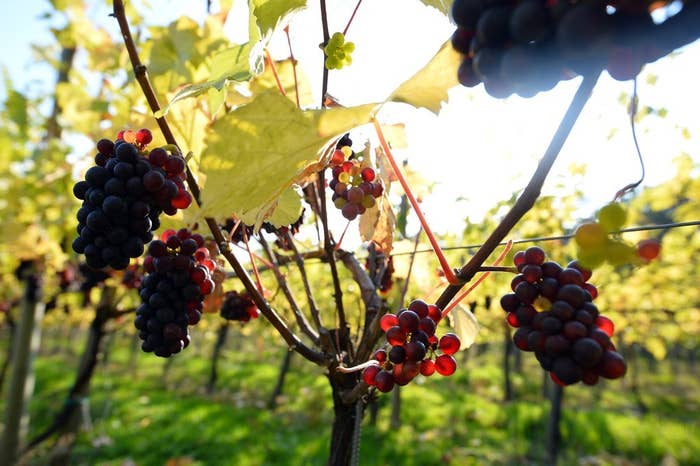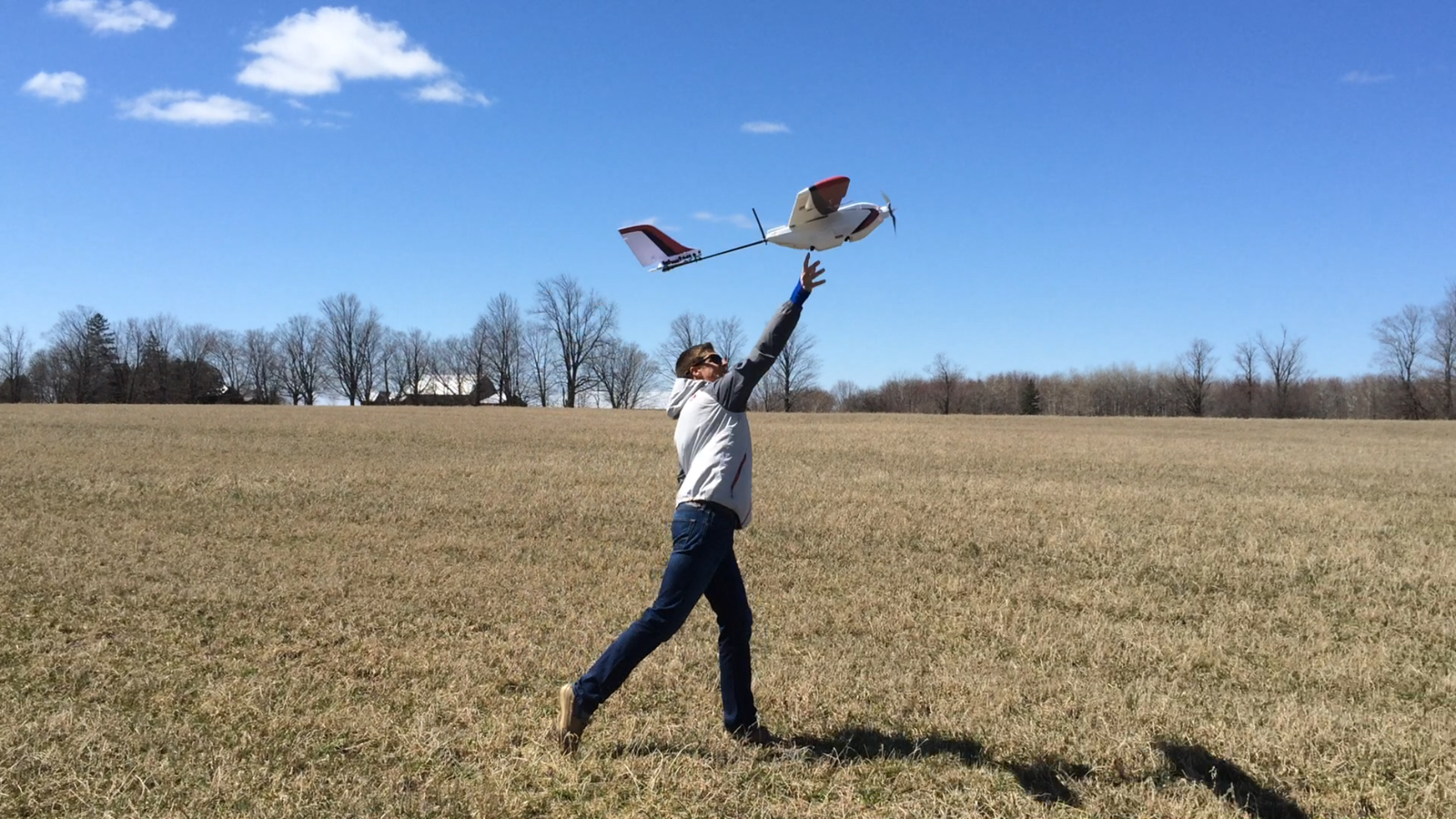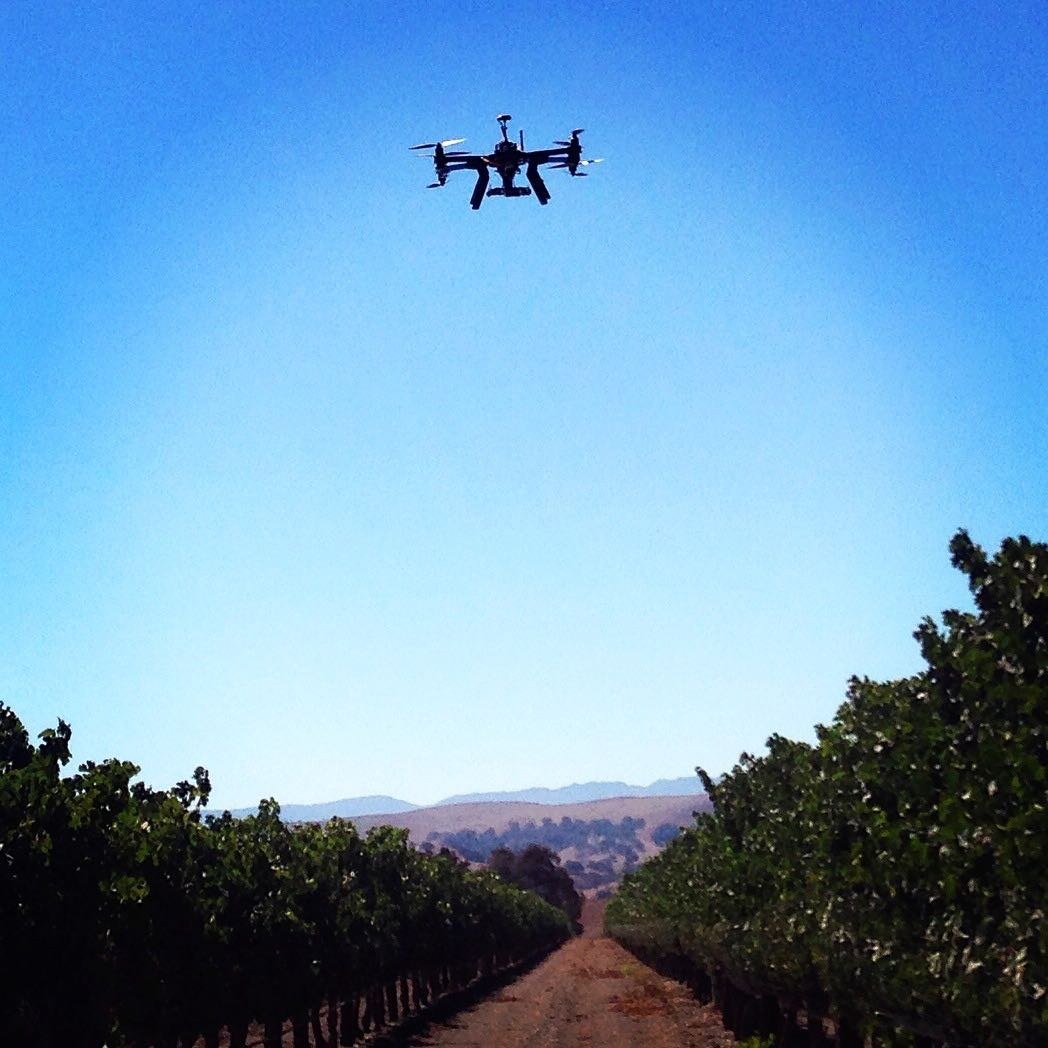
Seventy miles west of the Pentagon, in the foothills of Virginia’s Blue Ridge Mountains, a drone surveillance operation was underway. It’s just like thousands of other missions across the planet. Except, this one wasn’t in service to the god of war, but to the god of wine.
Under a cloudless November sky, with the wind carrying the first inkling of winter chill, Nick Gleis took hold of a controller for his DJI Phantom 2 quad copter while I manned the remote for a GoPro camera affixed to the drone’s belly. With a whoosh of air as it pushed off a picnic table and sent a pair of sunglasses careening, our drone was up and away.
Of all the fanciful adjectives attached to your favorite full-bodied red or complex white, “drone-grown” may well be the most unlikely. That, however, may soon change. A widely cited projection by the Association for Unmanned Vehicle Systems International puts agricultural drone use at 80% of the commercial market in the next 10 years — a massive hunk of the drone cash pie, totaling $76 billion. And that makes sense. Sprawling and sparsely populated, farms might make better homes for flying cameras that also conjure fears of prying eyes and bodily injury.
But the fruits of drone labor won’t just produce a superior pinot noir, they may also bring a smarter, more sustainable form of agriculture. The United Nations projects that by 2050, when the global population is expected to balloon to over 9 billion people, food production will need to increase by 70% to feed the world. But to get there, even in remote spaces, drones are first going to have to overcome privacy and legal hurdles.
Gleis, who’s building a niche in drone videography for vineyards, had me walk alongside his left, trailing him closely, our controllers tethered by cords, as we surveyed the grapevines of Rappahannock Cellars by air. Allan Delmare, whose family owns the vineyard and serves as marketing director, worked as our spotter, keeping the drone in sight as Gleis dove and climbed and I panned and swooped.
Before I began staring at my controller’s little video screen, Gleis recalled one of the first conversations he had with Allan’s dad, John, who looked at the drone’s footage for the first time. “I didn’t know I had that many vines missing!” John had said, astonished to see what can only be seen from up above. “It really opens up your perspective,” Allan said, comparing the ease and insight gleaned from drone-based aerial photography to the Sisyphean task of counting and tracking thousands of unique vines as a farmer on foot.
“It’s stepping back and getting a better picture of the painting,” said Gleis.

Where Gleis uses super-high-resolution 4K video to help vineyards market their wine and illuminate the health of their vines, another company in California is using flying robots and data analysis to help farmers grow better grapes and conserve resources.
“A vineyard is a living, breathing entity,” David Baeza, the CEO of the startup Vine Rangers, told BuzzFeed News. Using near-infrared cameras attached to drones, Baeza is able to see what farmers’ eyes cannot: soil moisture, sunlight absorption, ripeness, and disease.
Farmers looking out for the right level of water saturation or the presence of aggressive critters are usually limited to costly pictures from satellites, or the older, wildly inefficient, labor-intensive practice of inspecting plants one by one, hunched over. But with a vantage point above the crops, and imaging that maps intricate details of grape plots, Baeza offers farmers a new kind of awareness. “The key here is uniformity of quality,” he said. “The sooner a farmer is informed about irregularities in the crop the sooner they can take steps to improve the quality across the vineyard.”
As Ashutosh Natraj, Vine Rangers’ co-founder and chief technology officer explained, what appears to the naked eye as a bland, beige piece of earth is captured by the drone’s infrared cameras as vivid greens, reds, and indigos, colors that, in effect, share the invisible secrets of a plant’s well-being.
As the company’s drones traverse in serpentine paths, from 100 meters skyward down to just above the canopy, their images ultimately offer farmers fine-tuned data to calibrate levels of water, fertilizer, and pesticides, which helps vineyards produce fruits with just the right acidity and sweetness.
“For the vineyard farmers, it’s quite important to have precise data,” Natraj explained to BuzzFeed News. “Farmers are looking for day-to-day information.”
Deploying a drone’s remote sensing can inform farmers where to spray insecticides, hitting just the right plants. This not only yields a more consistent crop, it poses fewer risks to essential pollinators like honeybees, which are vulnerable to such chemicals. (In the future, ag-tech enthusiasts hope to have fleets of aerial drones doing the scanning and the spraying.)
Without a granular view to determine which plants are afflicted by disease, farmers traditionally resort to overkill. “It’s sort of like treating the common cold with chemo,” as Baeza put it. The principle of precision agriculture applies to the most essential of elements, too; due to continued drought and water shortages around the world, many technologists believe that the agricultural use of drones holds immense conservation promise.
“What sustainability means is the ability to do more with less — but it’s also about cost,” Ernest Earon, chief technology officer of PrecisionHawk, a North Carolina-based agricultural analytics firm, told BuzzFeed News. “If you can reduce the input costs required, you can make that same amount of food more available to parts of the world where it’s so desperately needed.”

Of course, agriculture is not the only industry being upturned and transformed by leaps in computing power, machine learning, and near limitless data storage. But just as networked cars and real-time biomedicine pose new and surprising privacy and economic dilemmas, so too does the high-tech farm.
“It is entirely possible that, in capturing data about the operator’s land, data about neighboring lands could also be acquired,” Shannon Ferrell, an agricultural economics professor at Oklahoma State University, told BuzzFeed News. For landowners, this raises concerns of privacy, trespassing, and data ownership.
Unlike the realms of personal finance and health information, where the data of consumers and patients are protected by federal laws like the Fair Credit Reporting Act and HIPPA, farm data captured by machines resides in the legal wilderness. Outside of a contract between farmers and ag-tech companies, or new legislation, Ferrell said, “There are few restrictions on how data can be collected and shared. This particular problem looms large with drones.”
According to Ferrell, federal law has little to say about newfangled flying sensors snagging information about open spaces when they are used by private entities and not law enforcement.
“A police helicopter cannot use infrared sensors to view the inside of a building without a search warrant, but what law would prevent a private-party aircraft using infrared sensors to detect the amount of grain in a grain bin?” he said. “One clearly has a privacy interest in one’s home, but it’s doubtful one has a legally recognized privacy interest in one’s grain bin.”
Beyond the privacy risks, the vast and minute collection of previously unknowable crop data may create unforeseeable consequences for farmers and the economic sectors they touch. Farm drones and the market intelligence spun out of them may alter how insurance companies price landholders and pool their risk. It may also reshape how traders buy and sell commodities futures, tampering speculation or introducing new forms of it. “There are currently no laws that say you can’t use perfectly legal means to get market information that is just way better and way faster than anyone else’s," Ferrell said.
Federal rules dictating drone use apply equally to rural areas as well as densely inhabited urban ones. But restrictions on flight operations, like always keeping the drone in sight and daytime-only flying, are expected to be relaxed or better tailored to industrial and agricultural environments in the years ahead.

Still, for farmers looking for predictive power, the potential upside may seem too good to pass up. Especially as the breakthroughs in agricultural technology — ultra-light cameras and sensors reducing an aircraft’s weight; swarms of small, powerful drones operating in sync; batteries allowing multiple farms across an entire geographic region to be scanned all in one flight — don’t seem far-fetched.
The impact of drone-infused agriculture will likely begin to be felt next year. It will be then that the Federal Aviation Administration will finalize its first set of rules regulating commercial drones, giving the official government nod to investors, manufacturers, and farmers looking to experiment with high-flying business models.
Offering farmers new and effective technology to help feed the world’s exploding population is a noble effort. That more enticing wine will be flowing in the process seems like something to be thankful for.
